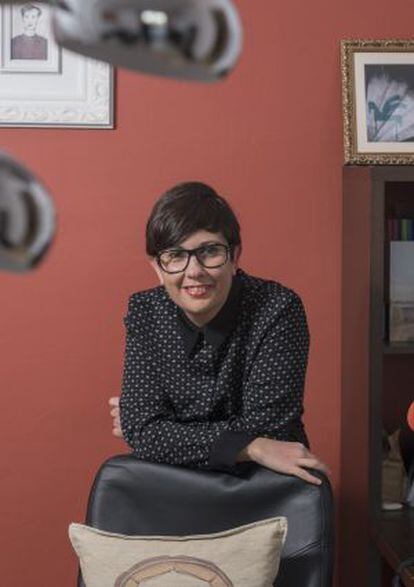The radio revolution
With 15 percent of listeners now tuning in online, internet stations are finding a niche

The old transistor radio is not dead yet, but the digital revolution has left its mark on the airwaves. The internet is populated with small stations that experiment with formats, languages, interactive content and personalized messages.
El Extrarradio, an online radio station that won an Ondas Award for innovation, is a case in point. Another is Radiocable, which was founded during the dotcom boom 15 years ago and has managed to survive by adapting to the times.
Just over five years ago, Spanish online radio listeners represented no more than one percent of the total radio audience. These days, internet listeners make up 15.4 percent of that group, according to a study presented at Radio y Red, a recent industry seminar organized by the regional public broadcaster in Aragón.
Although audio continues to be the main focus of online radio streaming, the medium has transformed into a multimedia product that can be accessed through any device and distributed through any channel.
El Extrarradio was launched in November 2012 by the journalist Olga Ruiz and a team of 10 people. A few weeks earlier they had started a crowdfunding campaign that soon raised the 4,000 euros they needed to buy technical equipment, soundproof a room at Ruiz's house (where they record and edit their programs) and set up a website. None of them make money from this work. It would seem that, for now at least, online radio is not a profitable business.
"It would be unfair to say that we failed to attract advertisers because we haven't spent any time on it," says Ruiz, who has worked in broadcast journalism for 15 years. "We focused on the quality of our work. Raising funds is our next step." When Ruiz lost her job last year, the season's programming was closed, and it was hard to find new employment. So she began mulling a new project altogether.
Former NATO head Javier Solana is one of the most recent guests on Radiocable
"A majority of online listeners seek the kind of content provided by conventional stations," adds Ruiz. "But little by little we are carving out a spot for ourselves. We haven't kept a tally of how many people have listened to our programs, but we do know that 94,000 users have downloaded them."
From the beginning, Ruiz and her team decided to leave the rush of modern radio work to others and go back to "handcrafted radio." This means that they devote a lot of time to editing their content, "around six or seven hours" for each podcast, in order to make sure everything has the same tone.
The beginnings of El Extrarradio share certain traits with the launch of Radiocable in 1997. Fernando Berlín set up the station's studio in a room inside his mother's house. "It was always meant to be a small business. We make sponsored programs and have agreements with the BBC and The Washington Post, who supply content," he explains.
Radiocable puts the accent on stories about the way technology is transforming reality. "We interview people who talk about globalization, about major changes, and about the idea that Spain projects in the world," adds Berlín.
In Mumbai, 90 percent of listeners connect to programs through cellphones
Federico Mayor Zaragoza, a former UNESCO director, and Javier Solana, who headed NATO in the 1990s, are some of the most recent guests on Radiocable.
Over the years, content has transformed to adapt to the requirements of a demanding audience. "People demand content that is visually more elaborate, with graphics, pull-down maps and video," says Berlín.
"If we want to reach people, we need to adapt to what they ask of us," confirms Rosa Pellicero, director of Aragón Radio, who has witnessed rapid growth in the number of listeners who follow radio broadcasts on digital media. "Radio is now tailored to listeners' tastes. The audience has become more selective. It demands radio streams on the internet, their cellphones and their tablets. And at any time of the day or night, too."
Pellicero mentions the case of Mumbai, where 90 percent of radio listeners connect to programs through their cellphones. And of the more than 20 million internet users in Spain (according to the General Media Study), she adds, around 1.5 million regularly use radio streams.
"Users are telling us that conventional signals can coexist with digital media and that content is consumed on all kinds of platforms," says Pellicero, who is convinced that it is good to adapt "fearlessly" to audience demands. It is not just music that people listen to online. Pellicero says general news and sports reports are increasingly popular, too.
Podcasts are often the most popular resource for online radio producers. The managers of El Extrarradio are aware that many people use them, recording themselves using a microphone at home and uploading the material on to the internet. "This is not what we do," says Ruiz. "We put the stress on quality radio. And good radio is hard to do."
El Extrarradio offers 12 programs, which include themes such as literature and social responsibility, via interviews and features.
Meanwhile, Radio Clan is trying to attract a young audience on non-traditional formats. Run by children's television channel Clan (part of state broadcaster TVE), it will soon offer a mobile application with web support so, with parental control, children can connect to radio streams.
"We need to renew our audiences," says a spokesperson for the state broadcaster. "If we catch them while they're young, later they might stay with us."










































